A homeschooling friend and I have used the same history program with our kids for years. We would often talk about letting our kids work on projects or presentations together, but we didn’t make it happen… until we hit the end of the program. As we planned curriculum for this year, we began talking about studying Canadian history together. Our Canadian history co-op was born!
If you’ve ever tried to start a homeschool co-op, want to make history more exciting for your kids, or need to teach more Canadian content, read on for what we’ve done with our Canadian history co-op. My friend and I, and our children, have really enjoyed doing a co-op this year. It’s been a great way to build community and have fun learning together.
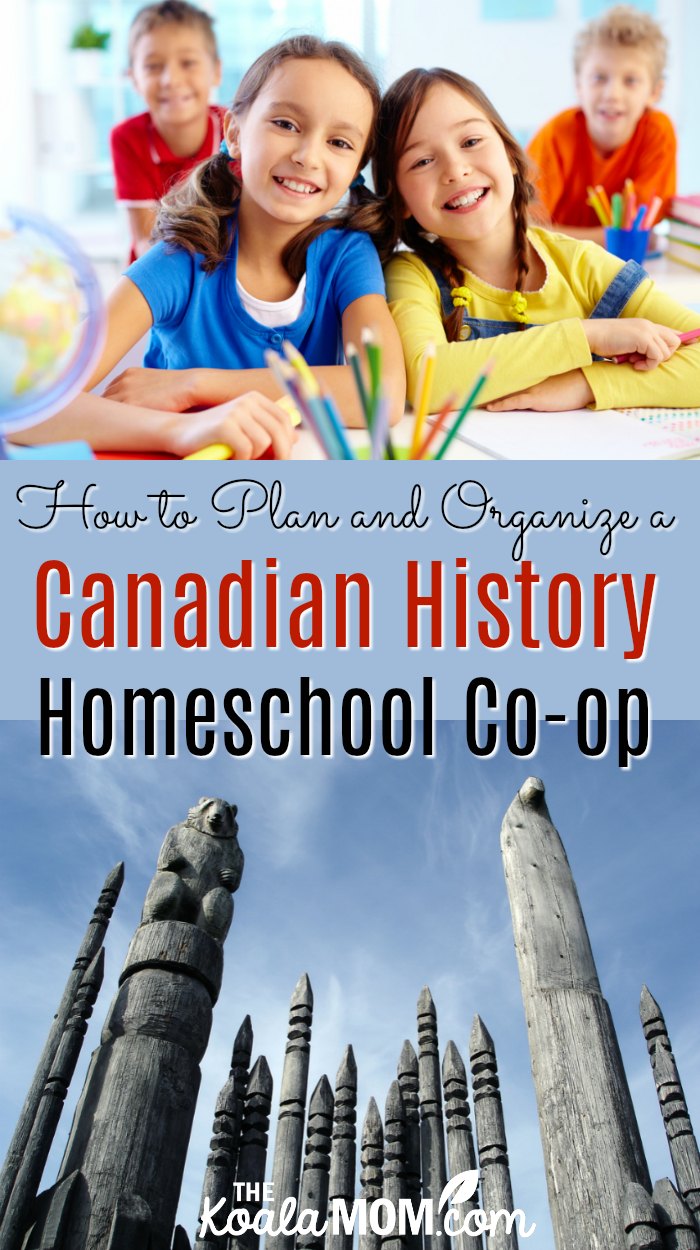
This post contains links to my reviews and affiliate links to help you find more information about resources I’ve recommended. As an Amazon associate, I earn a commission on qualifying purchases.
What you’ll find in this post:
- Getting our Canadian history co-op started
- Choosing a venue for a homeschool co-op
- Planning the content for a homeschool co-op
- Canadian history textbooks and books
- Student history notebooks
- Our Canadian Catholic heritage
- What a co-op day looked like
- Field trips for our Canadian history co-op
- Benefits of our Canadian history co-op
1. Getting Our Canadian History Co-op Started
As I mentioned, the Canadian history co-op idea started with my friend and I. We are both huge fans of Connecting with History, which we’ve followed for the past three years. The program is designed in a four-year cycle. However, the fourth year covers American history, as the World History unit isn’t yet written. Neither of us wanted to spend a year on American history, so we tossed around ideas for using the Connecting with History outline to study Canadian history. She’s a planner and I’m a history buff, and together we’ve made it happen!
Note: I do think that attempting to study history on our own has been easier because of our experience with Connecting with History. This program breaks history down into manageable time periods. It also uses great books and literature to bring history alive for kids. That was the experience we wanted to recreate for our children, although we were on our own to find Canadian resources.
My friend and I spent the summer sending emails and ideas back and forth. We researched curriculum and looked up ideas on Pinterest. We also reached out to other homeschool moms, whose kids were similar ages to ours, to see if they wanted to join our co-op. By September, we had five families involved with about twenty kids (plus a few babes-in-arms).
Once we knew which families were committed to our Canadian history co-op, we divided the kids up according to grades. We had four groups: pre-K, K-2, 3-5, and 6+. Four moms planned and led activities for one group during co-op days, while the fifth mom filled in as needed. For example, she might take over leading a group if one family was unable to make it. Or she helped with an activity that needed an extra pair of hands (like art projects!).
It was super helpful to have the babies and toddlers playing in the corner while trying to lead crafts and activities for the older kids. The girls also liked doing activities with their friends. We did combine groups, depending on the activity planned. For example, the older two groups all did a Viking ship art project.
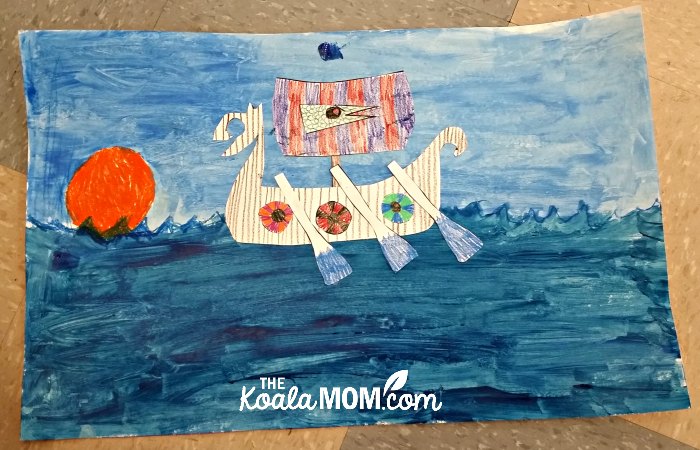
2. Choosing a Venue for a Homeschool Co-op
One of the hardest parts of planning our Canadian history co-op was finding the right venue. My friend and I had enough kids between us that our small homes weren’t a good option. Adding the other families meant we definitely needed a bigger space! I approached my parish about using their hall, but that didn’t work. We tried a few other ideas (including our local community centres) and ended up at another mom’s parish.
We were able to rent the church hall for every second Monday during the school year. The hall was large and bright, with a kitchen (so we could bring snacks and food) and washrooms. The kids had tons of fun running around together. We were able to break them into four groups in different corners of the hall to work on grade-specific activities, or to gather in the middle for larger group activities.
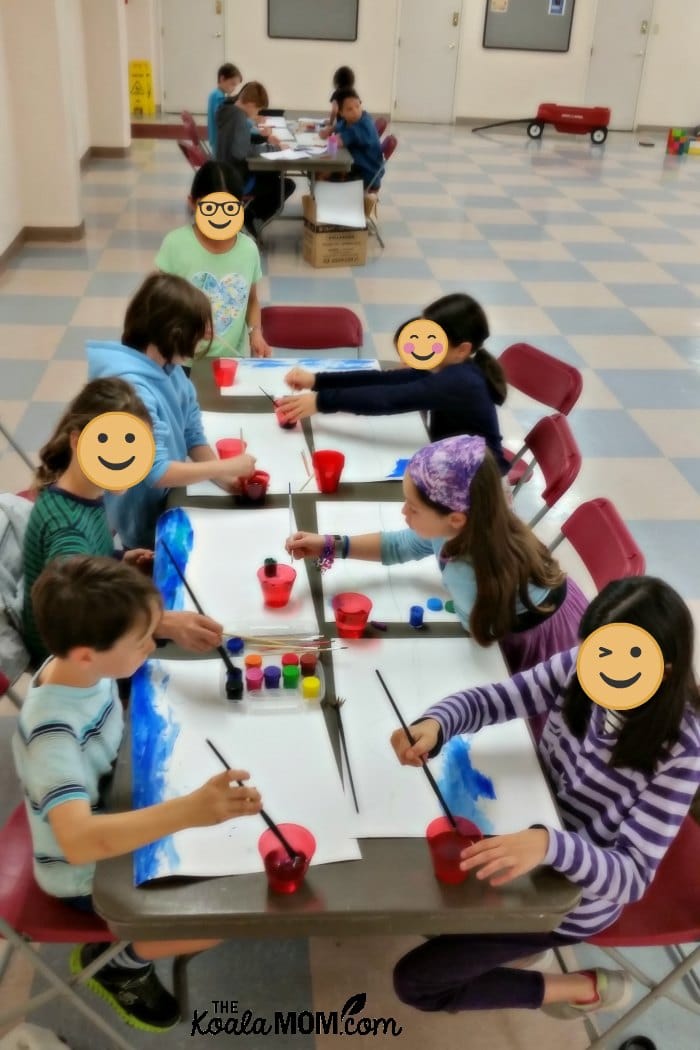
3. Planning the Content for Our Co-op
During the summer, my friend and I created a content outline for our Canadian history co-op. We choose two books to be our core textbooks and then broke the material in those books into roughly ten “units.” We covered one unit each month. That gave us two co-op days for each unit.
Our Canadian history units were:
- First Nations
- Vikings and Early Explorers
- New France (settlements, government, missions)
- Fur Trade and HBC
- Seven Years War and War of 1812
- Metis and North West Mounted Police
- Gold Rush and the Underground Railway
- World War I and the Depression
- World War II
- Canadian Government to the present
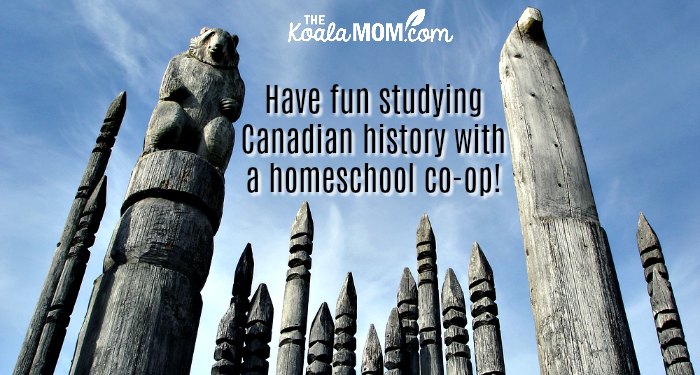
That’s a very rough outline of several thousand years of history. There was some overlap between topics (for example, the fur trade started in New France). However, this gave us a place to start in planning materials and activities. It also helped keep us on track. We all enjoyed studying the First Nations and could have easily spent several months there, but needed to move on to cover the rest of Canadian history.
Each family worked on covering the topic at home during the month. My friend and I came up with some suggested resources for the topics, but each family studied in their own way. One friend used Canadian history resources for her entire curriculum for the year, while another friend just borrowed a few books from the library to keep up with us. A co-op can still allow for this flexibility in interests and time!
4. Canadian History Textbooks & Books
We did have a “core text” that every family used for the Canadian history co-op. This ensured we were all starting in the same place and covering similar material. From that core text, each family was able to add as much other material as they wanted.
Our core text for our Canadian Catholic history co-op was:
- Courage & Conquest: Discovering Canadian History by Donna Ward. This textbook divides Canadian history into five units or thirty chapters. Each chapter is 1-2 pages with a resource list of nonfiction, fiction, videos and more, as well as comprehension questions or activities. The back of the book includes timeline cards and an index. This was a great resource for early elementary; I read it aloud to my Grade 1 student.
- We also had a self-published Canadian Catholic history textbook which many of us had bought as a group. We were unable to find more copies of this.
Other great resources we used included:
- The Story of Canada by Janet Lunn. This textbook is much more detailed, with glossy, full-colour pictures. It includes a chronology or timeline and index at the back of the book. This resource is better for upper elementary or high school students. It does have a secular, evolutionary bias that you may want to discuss with your students.
- Canada: A People’s History DVD. Created by CBC, this video is recommended for Grades 5+.
- 52 Weekly Stories about Canada by Ruth Solski. There are six books in this series, each spanning about two grade levels. The topics in the books vary but all cover Canada from a variety of perspectives. For example, the Grades 5-6 book covers First Nations, early explorers, famous Canadian disasters, famous Canadian inventors and inventions, famous Canadian foods, famous Canadian mysteries and ghost stories, famous historical women and First Nations men, famous Canadian tourist attractions and festivals.” Each week includes nonfiction stories with comprehension questions to answer.
- Explorers of Canada: Our Home and Native Land by Sonja E. Schild. This reproducible workbook covers all Canadian explorers. The first half of the book includes maps, charts and illustrations about the most important discoveries and achievements of Canadian explorers. The second half includes pictures, games, maps and word search puzzles to make the topic fun.
More great books to read in your Canadian history co-op:
5. Student History Notebooks
For our Canadian history co-op, I had my daughters each create a notebook or scrapbook. You could use either a binder or a notebook for this. We used a notebook with lined pages and just glued any extra activities into the notebook. In each of the girls’ notebooks, I created a Table of Contents, a timeline, and then left pages for their activities in the next year.
The girls were really excited about their notebooks and had a lot of fun adding their projects. At the end of the year, we had a lovely portfolio of their projects and writing. (This is easy to show to dads or homeschool teachers!)
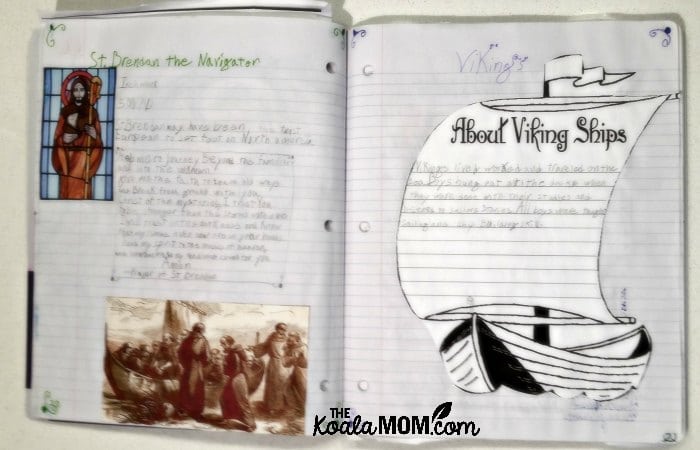
Some ideas for projects to include in the student notebooks:
- person, place or event profile
- maps
- scrapbook pages
- posters
- artwork
- book reports
- essays and presentations
- comprehension question answers
- research notes
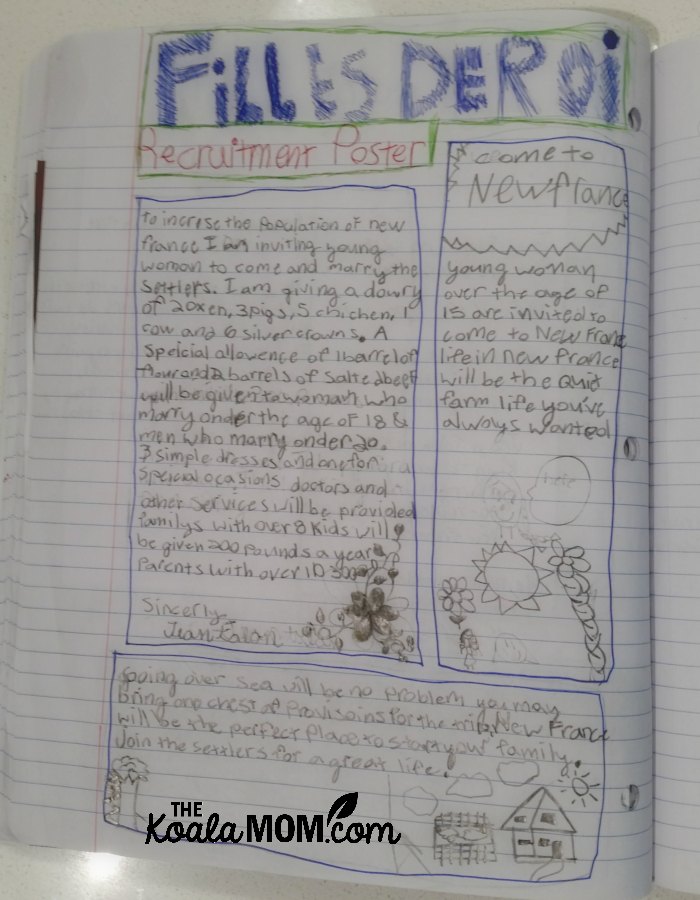
6. Our Canadian Catholic Heritage
All the families in our Canadian history co-op are Catholic. We wanted to integrate our Catholic faith into our learning. I knew that many of the early explorers were deeply religious, but I was still surprised to learn about Canada’s deeply Catholic roots. The founders of Canada, from well-known names like Samuel de Champlain to lesser known figures like Blessed Catherine of St. Augustine, were very Catholic.
We chose a patron saint for each of our units. For example, St. Kateri Tekakwitha was the patron saint of our First Nations unit. St. Brendan the Navigator (who may or may not have reached Canada’s shores) was the patron saint of our Vikings & Explorers unit. The Canadian martyrs were the patron saints of our New France unit, and so on.
We prayed together during our co-op days. We also fun doing an entirely Canadian All-Saints Day party with the kids. Each of them had to dress up as a Canadian saint or blessed (whom they were assigned) and tell the others about who they were. This was another great way to build community for our children, as they saw other kids who are also into their faith (and not just their parents!).
7. What a Co-op Day Looked Like
About twice a month, we met as a group to learn more about Canadian history together. (This varied each month, as we had a few months where kids were sick or other commitments interfered with co-op days.) Our goal for these days was to let our children experience group activities that are harder to do as homeschool families, practice public speaking skills, and have fun with what they were learning (so they’d remember it better!).

Each co-op day looked roughly like this:
- arrive at the hall and set up tables and chairs for the different groups
- prayer to St. Joseph (Patron Saint of Canada) and a group ice breaker activity
- oral presentations (assigned and prepared ahead of time)
- break into smaller groups for crafts / hands-on activities
- Pray the Angelus and eat lunch (individual or potluck)
- clean up and leave
That schedule varied slightly depending on the topic we were covering and who was able to come. We also planned a couple special co-op days for seasonal activities. At the end of October, we had a Canadian Catholic All-Saints Day Party and in December, we had an Advent Party. In the spring, we tried to plan more field trips (as the weather improved) rather than meeting in the parish hall.
8. Field Trips for Our Canadian History Co-op
We’ve also tried to integrate field trips into our Canadian history co-op. This will depend on what’s available in your area, of course.
Some ideas around Vancouver for historical field trips are:
- UBC Museum of Anthrology
- Fort Langley National Historic Site
- Vancouver Art Gallery
- Vancouver Maritime Museum
- Burnaby Village Museum
- Britannia Mine Museum
- Gulf of Georgia Cannery
In Victoria, you could visit:
Around Alberta, great field trips include:
Inquire about group or homeschool rates at your field trip destination. For example, the Royal BC Museum will let homeschoolers in for free if you book your visit ahead of time. You’ll also want to look up what the current exhibit at the museum or gallery is. Finally, we tried to coincide our visits to these locations with when in the year we were studying them, if possible.
9. Benefits of Our Canadian History Co-op
My girls absolutely loved co-op day and really looked forward to it. They got to see their friends regularly and do fun crafts and hands-on learning activities. My five-year-old enjoyed being in a little “class” led by another homeschool mom. (She’s never done preschool so this was a new experience for her!)
Co-op days were a great way to encourage the girls to do work they otherwise balked at. For example, my oldest dislikes writing and often grumbled and complained about doing her presentations, but she always got it done.
The co-ops were also a good way for us to integrate some learning experiences that are harder to do at home. For example, although the kids’ weren’t huge fans of doing presentations, we wanted them to work on their public speaking skills. We also worked on a group timeline and group posters, where everyone contributed ideas or facts.
I hope this helps inspire you with some ideas for starting your own co-op or teaching Canadian history in your homeschool!
Have you ever participated in a homeschool co-op?

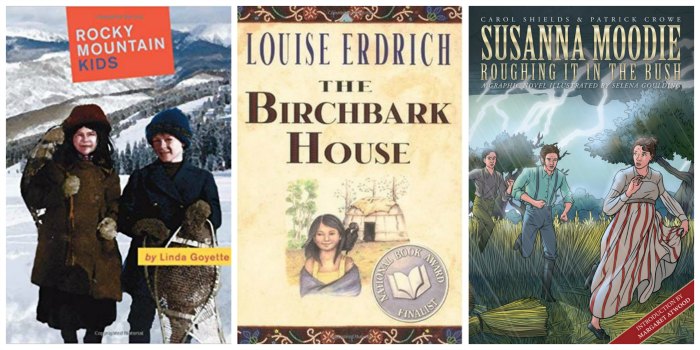
4 Comments
I’m glad you wrote this blog post! I’ve been seriously considering Connecting with History, as I love it’s strong Catholic focus (I’m currently using a Protestant curriculum, and am constantly tweaking things so it aligns with our faith) but was wondering about what to do about Cdn. history!
Arenda – Connecting with History is AWESOME for its Catholic perspective (I have a post about it too!). Unfortunately they are also American. There are no good answers for a Canadian Catholic History program. We made it halfway through the year attempting to create our own curriculum similar to RC History and then burnt out. 🙂 I hope these resources help you! If you find any other solutions, let me know! 🙂
Oh shoot! I’m sorry to hear you guys burnt out trying to make your own curriculum. I definitely feel your pain; it seems like every good quality Catholic curriculum out there is centred around American history and books. Canadian Catholic = quite the niche market, I suppose.
I think curriculum-writing could be a full-time job, and we were also trying to homeschool other subjects and keep up the housework and all the rest. I love history so I had fun with it, but just finding resources, reviewing it all, organizing it into neat units for the kids, etc., made me realize what an awesome curriculum RC History is. 🙂